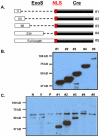Bacterial delivery of nuclear proteins into pluripotent and differentiated cells
- PMID: 21304583
- PMCID: PMC3029358
- DOI: 10.1371/journal.pone.0016465
Bacterial delivery of nuclear proteins into pluripotent and differentiated cells
Abstract
Numerous Gram negative pathogens possess a type III secretion system (T3SS) which allows them to inject virulent proteins directly into the eukaryotic cell cytoplasm. Injection of these proteins is dependent on a variable secretion signal sequence. In this study, we utilized the N-terminal secretion signal sequence of Pseudomonas aeruginosa exotoxin ExoS to translocate Cre recombinase containing a nuclear localization sequence (Cre-NLS). Transient exposure of human sarcoma cell line, containing Cre-dependent lacZ reporter, resulted in efficient recombination in the host chromosome, indicating that the bacterially delivered protein was not only efficiently localized to the nucleus but also retained its biological function. Using this system, we also illustrate the ability of P. aeruginosa to infect mouse embryonic stem cells (mESC) and the susceptibility of these cells to bacterially delivered Cre-NLS. A single two-hour infection caused as high as 30% of the mESC reporter cells to undergo loxP mediated chromosomal DNA recombination. A simple antibiotic treatment completely eliminated the bacterial cells following the delivery, while the use of an engineered mutant strain greatly reduced cytotoxicity. Utility of the system was demonstrated by delivery of the Cre-NLS to induced pluripotent stem cells to excise the floxed oncogenic nuclear reprogramming cassette. These results validate the use of T3SS for the delivery of transcription factors for the purpose of cellular reprogramming.
Conflict of interest statement
Figures





Similar articles
-
Efficient Gene Editing in Pluripotent Stem Cells by Bacterial Injection of Transcription Activator-Like Effector Nuclease Proteins.Stem Cells Transl Med. 2015 Aug;4(8):913-26. doi: 10.5966/sctm.2015-0030. Epub 2015 Jun 10. Stem Cells Transl Med. 2015. PMID: 26062981 Free PMC article.
-
The Impact of ExoS on Pseudomonas aeruginosa Internalization by Epithelial Cells Is Independent of fleQ and Correlates with Bistability of Type Three Secretion System Gene Expression.mBio. 2018 May 1;9(3):e00668-18. doi: 10.1128/mBio.00668-18. mBio. 2018. PMID: 29717012 Free PMC article.
-
Enhanced differentiation of human pluripotent stem cells into cardiomyocytes by bacteria-mediated transcription factors delivery.PLoS One. 2018 Mar 26;13(3):e0194895. doi: 10.1371/journal.pone.0194895. eCollection 2018. PLoS One. 2018. PMID: 29579079 Free PMC article.
-
Killing from the inside: Intracellular role of T3SS in the fate of Pseudomonas aeruginosa within macrophages revealed by mgtC and oprF mutants.PLoS Pathog. 2019 Jun 20;15(6):e1007812. doi: 10.1371/journal.ppat.1007812. eCollection 2019 Jun. PLoS Pathog. 2019. PMID: 31220187 Free PMC article.
-
Intracellular localization and processing of Pseudomonas aeruginosa ExoS in eukaryotic cells.Mol Microbiol. 2000 Jul;37(2):287-99. doi: 10.1046/j.1365-2958.2000.01990.x. Mol Microbiol. 2000. PMID: 10931325
Cited by
-
Intracellular delivery of biologic therapeutics by bacterial secretion systems.Expert Rev Mol Med. 2017 Apr 6;19:e6. doi: 10.1017/erm.2017.7. Expert Rev Mol Med. 2017. PMID: 28382885 Free PMC article. Review.
-
Directed Differentiation of Embryonic Stem Cells Into Cardiomyocytes by Bacterial Injection of Defined Transcription Factors.Sci Rep. 2015 Oct 9;5:15014. doi: 10.1038/srep15014. Sci Rep. 2015. PMID: 26449528 Free PMC article.
-
Direct reprogramming of fibroblasts to myocytes via bacterial injection of MyoD protein.Cell Reprogram. 2013 Apr;15(2):117-25. doi: 10.1089/cell.2012.0058. Epub 2013 Feb 25. Cell Reprogram. 2013. PMID: 23438194 Free PMC article.
-
Bacterium-Derived Cell-Penetrating Peptides Deliver Gentamicin To Kill Intracellular Pathogens.Antimicrob Agents Chemother. 2017 Mar 24;61(4):e02545-16. doi: 10.1128/AAC.02545-16. Print 2017 Apr. Antimicrob Agents Chemother. 2017. PMID: 28096156 Free PMC article.
-
Generation of Induced Pluripotent Stem (iPS) Cells by Nuclear Reprogramming.Stem Cells Int. 2011;2011:619583. doi: 10.4061/2011/619583. Epub 2011 Oct 5. Stem Cells Int. 2011. PMID: 22007240 Free PMC article.
References
-
- Cornelis GR. The type III secretion injectisome. Nat Rev Micro. 2006;4:811–825. - PubMed
-
- Galan JE, Wolf-Watz H. Protein delivery into eukaryotic cells by type III secretion machines. Nature. 2006;444:567–573. - PubMed
-
- Tampakaki A, Fadouloglou V, Gazi A, Panopoulos N, Kokkinidis M. Conserved features of type III secretion. Cell Micro. 2004;6:805–816. - PubMed
-
- Epaulard O, Toussaint B, Quenee L, Derouazi M, Bosco N, et al. Anti-tumor immunotherapy via antigen delivery from a live attenuated genetically engineered Pseudomonas aeruginosa type III secretion system-based vector. Mol Ther. 2006;14:656–661. - PubMed
Publication types
MeSH terms
Substances
Grants and funding
LinkOut - more resources
Full Text Sources
Other Literature Sources

